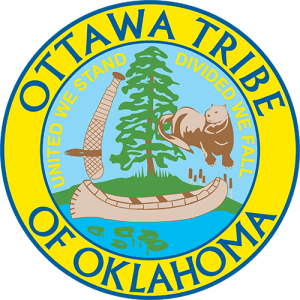
Notable Documents in Ottawa Tribal History
A full page image of the Treaty of Greenville signatory page
Treaty of Greenville
On July 28, 1795, Ottawa tribal leaders were in the midst of negotiations for the Treaty of Greenville that formally ended the Northwest Indian War.
Facing the invasion of their lands by settlers and military forces of the newly formed United States, Natives of the Great Lakes region united, and they resoundingly defeated the campaign of Josiah Harmar in 1790 and army of Arthur St. Clair in 1791. At the Battle of Fallen Timbers in 1794, however, the Native alliance faced defeat, and the Ottawas and other tribes ceded claims to southern Ohio in the Treaty of Greenville.
The head Ottawa signatory was Au-goosh-away (or Egushawa)—a remarkable individual regarded as the successor to Pontiac, one of the most influential Native leaders of the late eighteenth century, and a powerful war leader. Although in his sixties, Au-goosh-away actively participated in the Battle of Fallen Timbers and suffered severe injuries.
Tribal leaders often signed treaties with a symbol of their doodem or clan, and the Ottawa bands who resided near the Maumee River were generally of the Otter clan. Pontiac signed documents with an image of an Otter on its back, and it appears that Au-goosh-away did the same. This is a close-up of the Ottawa signature symbols from the Treaty of Greenville. This image shows Pontiac’s symbol used to sign a 1766 agreement.
You can read more about Au-goosh-away here.
Full images of the Treaty of Greenville can be found here.
A warranty deed marking a land sale in Kansas.
Treaty with the Ottawa of Blanchard's Fork and Roche de Boeuf, 1862
Treaties are important. In the 1850s, most tribal members could not read, so tribal leaders insisted that their missionary read old Ottawa treaties aloud on cold winter evenings. On June 24th, 1862, the Ottawas signed the second-to-last treaty they would make with the United States government. Signed in Washington D.C in the midst of the Civil War, this treaty paved the way for Ottawa University, American citizenship, and the Ottawas’ first experiences with allotment and termination.
According to the treaty, the Ottawa tribal “organization, and their relations with the United States as an Indian tribe shall be dissolved and terminated at the expiration of five years from the ratification…and every one of them, shall be deemed and declared to be citizens of the United States.” The treaty also provided for the allotment of the Ottawa reservation in Kansas, with most members receiving 80 or 160 acres.
As Kansas filled up with settlers, the Ottawas faced mounting pressure for their lands. As successful farmers and businessmen, the Ottawas thought they could navigate American society if provided equality with their white counterparts, and rather than face removal, the Ottawas agreed to the termination of their formal political relationship with the United States and the allotment of their communal lands in return for “all the rights, privileges, and immunities” of American citizenship.
To aid in the transition to citizenship, the treaty set aside “twenty thousand acres…for the purpose of endowing a school for the benefit of said Ottawas.” The treaty stipulated, “the children of the Ottawas and their descendants, no matter where they may emigrate, shall have the right to enter said school and enjoy all the privileges thereof.”
The Ottawas held up their end of the bargain. Shortly after the treaty, Ottawas enlisted in the Union Army and even started voting in political elections; however, the Ottawa Indian Agent embezzled tribal funds, Kansas law and incoming settlers did not treat the Ottawas as equal citizens, and sale of the land set aside to establish an educational institution for the Ottawas’ benefit fell into corrupt hands, including those of John Tecumseh (Tauy) Jones, a Chippewa adopted by the Ottawas. For over a century after its founding, Ottawa tribal members saw little benefit from the educational institution their lands had established through this treaty.
Although tribal members optimistically imagined a new political relationship as full American citizens, Ottawa disappointment with the results led the Tribe to buy a new reservation and move to Indian Territory following a new treaty in 1867.
Language Journal from Ottawa Chief John Early, 1887
The account from a missionary publication lays out the first year of the school. Click on the picture to read a pdf of the full article.
A Missionary Account of the Ottawa Mission School
As one of their first acts after removing from Kansas and settling in Indian Territory in 1870, the Ottawa tribal council set aside land for educational purposes and ordered the construction of a schoolhouse—this became the Ottawa Mission School.
Quaker missionaries Asa and Emeline Tuttle served as the first instructors at the school. One emphasis was reading the Bible, and by 1871 two of the small Ottawa children had read the whole New Testament, with one of the children spending his evenings reading to his parents. The curriculum was differentiated based on sex. Boys learned farming skills and girls studied the “arts of housewifery,” including sewing for one hour each day. In 1872, the girls produced 25 quilts for tribal members in preparation for winter.
This page is incomplete.
Check back later for more interesting Ottawa history!
Rhonda Hayworth
Library/Archives, Higher Ed., Tribal Historic Preservation
Office: 918-542-5191
E-mail: rhonda.oto@gmail.com
Additional page contributions courtesy of Ottawa Tribal Member David Dry, PhD.






